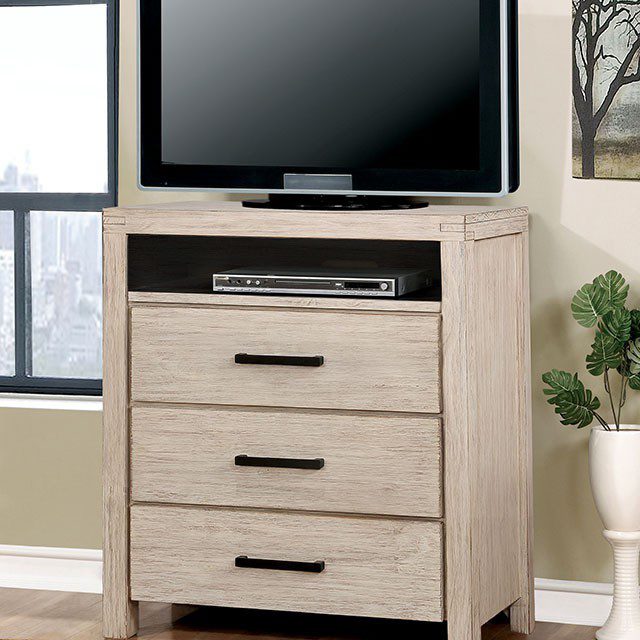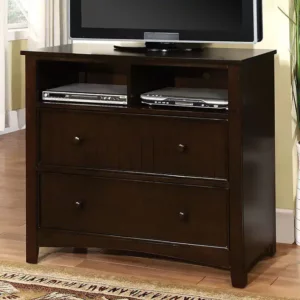Media Dressers: The Perfect Blend of Style and Functionality

When it comes to organizing your living space, media dressers stand out as an essential piece of furniture. Combining practicality with style, media dressers are designed to hold and organize your entertainment equipment, such as TVs, sound systems, and gaming consoles, all while helping to keep your space neat and functional.
In this article, we'll dive deep into the world of media dressers—exploring their features, benefits, materials, and styles. Whether you’re looking for a new TV stand or seeking extra storage, a media dresser could be the perfect solution for your home.
What Is a Media Dresser?
A media dresser is a multi-functional piece of furniture primarily designed to store media-related items, such as a television, DVD players, game consoles, and accessories. These dressers often combine open shelving with drawers and cabinets to keep everything from cables to remote controls neatly tucked away, making them perfect for organizing your entertainment space.
Why Choose a Media Dresser?
- Versatility: Media dressers come in various sizes and styles, making them suitable for different spaces, from apartments to large living rooms.
- Storage: These pieces provide ample storage options for electronics, DVDs, and other items, helping to reduce clutter in your home.
- Aesthetics: With a wide variety of designs—from modern to traditional—media dressers can complement any room decor.
Key Features of Media Dressers

Media dressers aren’t just about storing electronics; they are designed to enhance the organization and visual appeal of your living space. Below are the most notable features to look for when selecting a media dresser.
1. Cable Management
One of the biggest challenges of modern electronics is managing cables. Many media dressers come equipped with built-in cable management solutions, such as holes or channels, to help keep wires neat and out of sight.
2. Storage Options
Media dressers often feature a mix of open shelves, drawers, and cabinets. This combination allows you to store everything from gaming consoles to DVDs, making it easier to keep all your media accessories organized and accessible.
3. Vented Spaces
Many media dressers are designed with ventilation in mind. To prevent overheating of your electronics, some units include perforated panels or open spaces at the back to promote airflow, ensuring your devices stay cool.
4. Durable Materials
Media dressers are often made from durable materials like wood, laminate, or metal. These materials are designed to withstand the weight of electronics while adding a stylish touch to the room. Wood options, in particular, can last for many years if well-maintained.
5. Sleek Design
While functionality is key, media dressers are often designed with aesthetics in mind as well. Whether you prefer a modern, minimalist look or a more traditional style, you’ll find a dresser that fits your room’s overall decor.
Types of Media Dressers
Media dressers come in various styles and designs to suit different tastes and needs. Let’s take a look at the most popular types available.
1. Traditional Media Dressers
Traditional media dressers often feature ornate wood carvings and intricate detailing, making them a perfect fit for classic or vintage-inspired interiors. These dressers may offer more extensive storage options and are often built to accommodate larger televisions.
2. Contemporary Media Dressers
Contemporary media dressers are known for their clean lines and modern design. These units often have minimalist features, such as open shelving and sleek finishes, making them ideal for those who prefer a more streamlined, modern look.
3. Rustic Media Dressers
Rustic media dressers bring warmth and texture to a room. Typically made from reclaimed wood or distressed finishes, these dressers offer a cozy, farmhouse-style aesthetic that fits perfectly in casual or rustic settings.
4. Minimalist Media Dressers
Minimalist media dressers focus on simplicity and practicality. These units often feature only a few drawers or shelves, offering just enough storage without overwhelming the room with extra features. They’re perfect for small spaces or anyone who prefers an uncluttered design.
Materials Used in Media Dressers
The material of your media dresser will impact its durability, appearance, and functionality. Here are the most common materials used in these furniture pieces:
1. Wood
Wood is one of the most popular materials for media dressers due to its durability and timeless appeal. Whether it’s oak, pine, or walnut, wood offers a natural look that works well with most interior styles. Wood dressers are also sturdy enough to hold heavy electronics.
2. Laminate
Laminate is a synthetic material designed to resemble wood but at a more affordable price point. It’s easy to clean, resistant to scratches, and available in a variety of finishes. Laminate media dressers are perfect for those on a budget who still want a stylish, functional unit.
3. Metal
Metal media dressers offer a sleek, industrial look. These units are typically lighter than wood and can be combined with other materials like glass or wood to create a unique, modern design. They are especially durable and easy to maintain.
4. Mirrored
Mirrored media dressers are ideal for adding a touch of luxury to your room. These dressers feature reflective surfaces, making the room appear larger and brighter. However, they can be delicate and may require more maintenance than other materials.
How to Choose the Right Media Dresser
Now that you know more about media dressers, you may be wondering how to choose the best one for your home. Here are some tips to help you make an informed decision:
1. Consider the Size of Your TV
Measure your TV and ensure that the media dresser you choose is wide enough to accommodate it. You don’t want a dresser that’s too small to support your television, so make sure the unit is appropriately sized.
2. Think About Your Storage Needs
Do you have a lot of media accessories like DVDs, video games, or remotes? If so, look for a media dresser with ample storage space. Units with both open shelving and closed drawers are ideal for organizing various items.
3. Match Your Room’s Style
Consider the overall aesthetic of your room when choosing a media dresser. If your space is modern, a sleek, minimalist dresser may work best. If you have a more traditional or rustic setting, opt for a wooden or distressed unit that complements the decor.
4. Material Preference
Choose a material that suits both your aesthetic preferences and practical needs. Wood is durable and versatile, while laminate is more affordable. Metal dressers offer a modern edge, and mirrored dressers add a luxurious touch.
Frequently Asked Questions
What’s the difference between a media dresser and a regular dresser?
A media dresser is designed specifically to house electronic devices like a TV, sound system, or gaming console. Regular dressers are primarily used for clothing storage and lack the necessary features to accommodate electronics.
How do I care for my media dresser?
Regular dusting and occasional cleaning with a damp cloth are essential to maintain the dresser’s appearance. If you have a wood dresser, you may also want to polish it occasionally to keep it looking fresh. For laminated units, use a gentle cleaner to avoid damaging the surface.
Can I use a media dresser in a bedroom?
Yes, media dressers can be used in bedrooms, especially if you need additional storage for media devices. Just make sure to choose a dresser that fits your space without overcrowding the room.
Final Takeaways
Media dressers are a versatile and practical addition to any home. They help organize your electronics while offering additional storage for other household items. With a variety of styles and materials available, you’re sure to find one that fits your needs and complements your home’s design. Whether you opt for a traditional wooden piece or a sleek metal unit, a media dresser can enhance your entertainment setup and create a more organized living space.